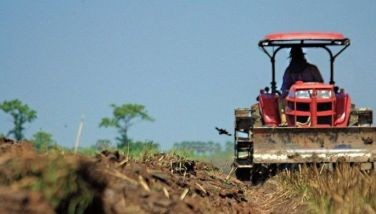Home-grown edible mushrooms a hit among North Luzon farmers
August 7, 2005 | 12:00am
Edible fungi or home-grown edible mushrooms are now being promoted nationwide in an effort to help farmers diversify their crops through biotechnology.
The Department of Agriculture (DA) reported that home-grown edible mushrooms are now making waves in several provinces in Northern Luzon, as more enterprising farmers have started to venture in the mass spawning of this edible delicacy.
Director Alice Ilaga of the DA-Biotechnology Program Implementation Unit (BPIU) said the agency is fully supporting the latest move by the farmers to produce and supply more edible fungi to the growing consumer demands.
"The latest trend in agricultural innovation is just proof that the Filipino farmers are now developing ways to explore other potential products in order to alleviate their present conditions," Ilaga said. "The edible mushroom technology is a new technique that needs less open space, can be grown in enclosed indigenous structures, and with minimal capital."
In Malasiqui, Pangasinan, a farmers’ cooperative is now in the thick to mass-producing edible mushrooms. The mushroom spawning facilities which is being managed by the BIBA-DIWA Multi-Purpose Cooperative (BDMPC) has added more darkened enclosures for spawning more abalone, oyster and banana (volvarela) mushrooms.
The mushrooms spawned inside dark bamboo cottages in the barangay await harvest in just three weeks. Applying natural biotechnology process, the edible mushrooms are spawned on banana leaves and saw dust where they propagate under cover of darkness.
Fernando Lopez, BDMPC executive committee chairman, said the mushroom industry in Pangasinan has been existence for sometime but has not made headway because edible fungi are normally found as canned consumables in supermarkets, and not in public markets where it is supposed to be available to the public.
The DA also noted that the latest spawning technology being applied by the cooperative has increased the supply of edible mushrooms in public markets.
"People tend to develop a taste for a food item if aside from being a qualified delicacy, the supply is reliable and the cost is reasonable," Lopez said. "More people can be encouraged to go into mushroom production in a larger scale if they can be convinced that its cost efficient technologies can be easily acquired and that, developed edible mushroom species can be profitably produced."
Dr. Edmond Mendoza, BDMPC consultant, said students of the Bayambang National High School have gone into mushroom culture and production as one of their practicum activities. He said the students were able to internalize concepts to make it a viable source of livelihood.
The Department of Agriculture (DA) reported that home-grown edible mushrooms are now making waves in several provinces in Northern Luzon, as more enterprising farmers have started to venture in the mass spawning of this edible delicacy.
Director Alice Ilaga of the DA-Biotechnology Program Implementation Unit (BPIU) said the agency is fully supporting the latest move by the farmers to produce and supply more edible fungi to the growing consumer demands.
"The latest trend in agricultural innovation is just proof that the Filipino farmers are now developing ways to explore other potential products in order to alleviate their present conditions," Ilaga said. "The edible mushroom technology is a new technique that needs less open space, can be grown in enclosed indigenous structures, and with minimal capital."
In Malasiqui, Pangasinan, a farmers’ cooperative is now in the thick to mass-producing edible mushrooms. The mushroom spawning facilities which is being managed by the BIBA-DIWA Multi-Purpose Cooperative (BDMPC) has added more darkened enclosures for spawning more abalone, oyster and banana (volvarela) mushrooms.
The mushrooms spawned inside dark bamboo cottages in the barangay await harvest in just three weeks. Applying natural biotechnology process, the edible mushrooms are spawned on banana leaves and saw dust where they propagate under cover of darkness.
Fernando Lopez, BDMPC executive committee chairman, said the mushroom industry in Pangasinan has been existence for sometime but has not made headway because edible fungi are normally found as canned consumables in supermarkets, and not in public markets where it is supposed to be available to the public.
The DA also noted that the latest spawning technology being applied by the cooperative has increased the supply of edible mushrooms in public markets.
"People tend to develop a taste for a food item if aside from being a qualified delicacy, the supply is reliable and the cost is reasonable," Lopez said. "More people can be encouraged to go into mushroom production in a larger scale if they can be convinced that its cost efficient technologies can be easily acquired and that, developed edible mushroom species can be profitably produced."
Dr. Edmond Mendoza, BDMPC consultant, said students of the Bayambang National High School have gone into mushroom culture and production as one of their practicum activities. He said the students were able to internalize concepts to make it a viable source of livelihood.
BrandSpace Articles
<
>
- Latest
Latest
Latest
March 4, 2024 - 3:32pm
By Ian Laqui | March 4, 2024 - 3:32pm
March 4, 2024 - 2:12pm
By Kristine Daguno-Bersamina | March 4, 2024 - 2:12pm
February 17, 2024 - 2:31pm
February 17, 2024 - 2:31pm
February 13, 2024 - 7:24pm
By Gaea Katreena Cabico | February 13, 2024 - 7:24pm
February 13, 2024 - 7:17pm
By Ian Laqui | February 13, 2024 - 7:17pm
Recommended




























